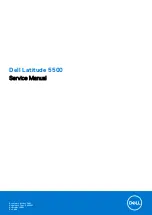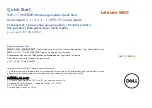
102
L i f e B o o k A S e r i e s N o t e b o o k – S e c t i o n N i n e
Program
An integrated set of coded commands to your
computers telling your hardware what to do and how
and when to do it.
RAM
Random Access Memory. A hardware component of
your LifeBook notebook that holds binary information
(both program and data) as long as it has the proper
power applied to it.
RAM Module
A printed circuit card with memory and associated
circuitry which allows the user to add additional
memory to the computer without special tools.
Reset
The act of reloading the operating system. A reset erases
all information stored in RAM.
Restart
See Reset.
Resume
To proceed after interruption. In your LifeBook note-
book this refers to returning to active operation after
having been in one of the suspension states.
ROM
Read Only Memory. A form of memory in which infor-
mation is stored by physically altering the material. Data
stored in this way can not be changed by your LifeBook
notebook and does not require power to maintain it.
SD
See
Secure Digital.
SDRAM
Synchronous Dynamic Random Access Memory.
Secure Digital
A Secure Digital (SD) card is a small memory card that
allows portable storage among a variety of devices, such
as cell phones, GPS systems, digital cameras, and PDAs.
SD cards transfer data quickly, with low battery
consumption. Like the memory stick, it uses flash
memory architecture. This means that a power source is
not required to retain data.
Shadow RAM
A technique of copying data or applications stored in
ROM (Read Only Memory) into RAM (Random Access
Memory) for access during actual operation. RAM is
much faster to access than ROM, however ROM
contents are not lost when power is removed.
Shadowing allows permanently stored information
to be rapidly accessed.
SRAM
Static random access memory. A specific technology of
making RAM which does not require periodic data
refreshing.
SSID
Service Set Identifier
Specifies which network you are joining. Some systems
allow you to specify any SSID as an option so you can
join any network.
Status Indicator
A display which reports the condition of some portion
of your hardware.
Stereo (audio)
A system using two channels to process sound from two
different sources.
Stroke (keyboard)
The amount of travel of a key when it is pressed from
resting to fully depressed.
Suspend
To make inoperative for a period of time. Your LifeBook
notebook uses various suspension states to reduce power
consumption and prolong the charge of your battery.
SVGA
Super VGA. Standard that provides 800x600 pixel
resolution and a palette of 16M colors.
S-Video
Super Video. A component video system for driving a
TV or computer monitor.
System Clock
An oscillator of fixed precise frequency which
synchronizes the operation of the system and is counted
to provide time of day and date.
TFT
Thin Film Transistor – A technology for flat display
panels which uses a thin film matrix of transistors to
control each pixel of the display screen individually.
UL
Underwriters Laboratories – An independent organiza-
tion that tests and certifies the electrical safety of devices.
UMA
Unified Memory Architecture. A computer architecture
that uses graphics chips on the motherboard that use
part of the main memory for video memory.
USB
Universal Serial Bus. The USB 2.0 specification is a
peripheral bus standard for connecting external devices
at up to 480 Mbps. Some features of the standard
include support for up to 127 concurrent USB devices,
dynamic insertion and removal of devices, and self-iden-
tifying peripheral configuration for true plug-and-play
functionality. USB 1.0 connects external devices at up to
11 Mbps. USB 2.0 is backward-compatible with USB 1.0
devices to allow you to connect older devices to the
ports.
A3040-B6FH-8841-01EN-01.book Page 102 Wednesday, January 18, 2006 9:31 AM
Summary of Contents for Lifebook A3040
Page 6: ...L i f e B o o k A S e r i e s N o t e b o o k ...
Page 7: ...1 1 Preface ...
Page 8: ...2 L i f e B o o k A S e r i e s N o t e b o o k ...
Page 10: ...4 L i f e B o o k A S e r i e s N o t e b o o k S e c t i o n O n e ...
Page 11: ...5 2 Getting to Know Your Computer ...
Page 12: ...6 L i f e B o o k A S e r i e s N o t e b o o k S e c t i o n T w o ...
Page 30: ...24 L i f e B o o k A S e r i e s N o t e b o o k S e c t i o n T w o ...
Page 31: ...25 3 Getting Started ...
Page 32: ...26 L i f e B o o k A S e r i e s N o t e b o o k S e c t i o n T h r e e ...
Page 39: ...33 4 User Installable Devices and Media ...
Page 40: ...34 L i f e B o o k A S e r i e s N o t e b o o k S e c t i o n F o u r ...
Page 56: ...50 L i f e B o o k A S e r i e s N o t e b o o k S e c t i o n F o u r ...
Page 57: ...51 5 Using the Integrated Wireless LAN ...
Page 58: ...52 L i f e B o o k A S e r i e s N o t e b o o k S e c t i o n F i v e ...
Page 72: ...66 L i f e B o o k A S e r i e s N o t e b o o k S e c t i o n F i v e ...
Page 73: ...67 6 Troubleshooting ...
Page 74: ...68 L i f e B o o k A S e r i e s N o t e b o o k S e c t i o n S i x ...
Page 88: ...82 L i f e B o o k A S e r i e s N o t e b o o k S e c t i o n S i x ...
Page 89: ...83 7 Care and Maintenance ...
Page 90: ...84 L i f e B o o k A S e r i e s N o t e b o o k S e c t i o n S e v e n ...
Page 94: ...88 L i f e B o o k A S e r i e s N o t e b o o k S e c t i o n S e v e n ...
Page 95: ...89 8 System Specifications ...
Page 96: ...90 L i f e B o o k A S e r i e s N o t e b o o k S e c t i o n E i g h t ...
Page 100: ...94 L i f e B o o k A S e r i e s N o t e b o o k S e c t i o n E i g h t ...
Page 103: ...97 9 Glossary ...
Page 104: ...98 L i f e B o o k A S e r i e s N o t e b o o k S e c t i o n N i n e ...
Page 110: ...104 L i f e B o o k A S e r i e s N o t e b o o k S e c t i o n N i n e ...
Page 114: ...108 L i f e B o o k A S e r i e s N o t e b o o k ...
Page 115: ...109 I n d e x ...
Page 116: ...110 L i f e B o o k A S e r i e s N o t e b o o k ...
Page 117: ...111 I n d e x ...
Page 118: ...112 L i f e B o o k A S e r i e s N o t e b o o k ...
Page 119: ...113 I n d e x ...
Page 120: ...114 L i f e B o o k A S e r i e s N o t e b o o k ...













































